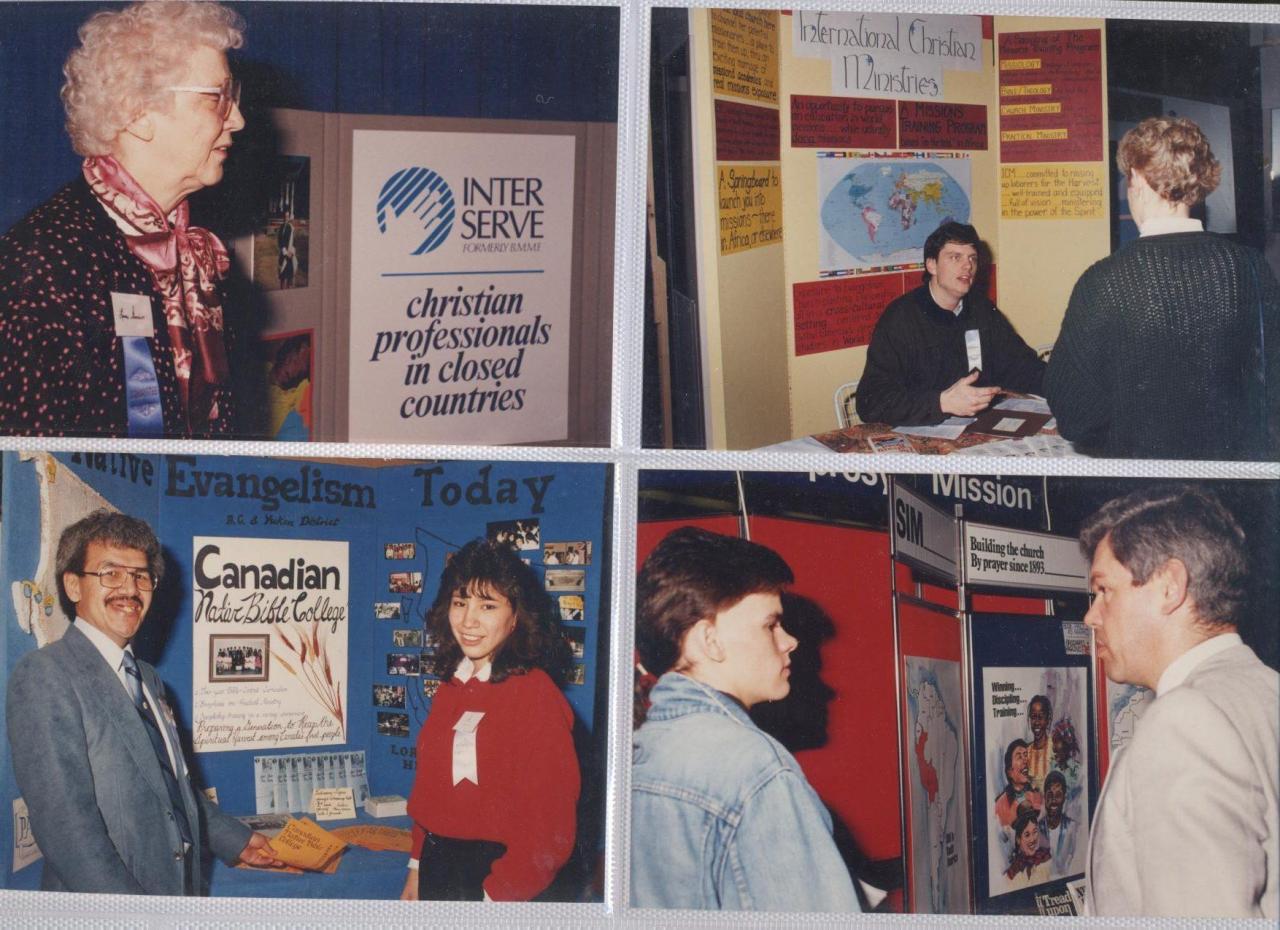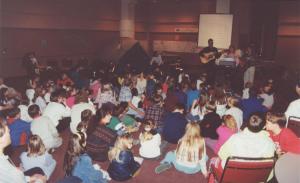
Timeline
During 2022 we put together a timeline of some of the highlights of the history of Missions Fest and Mission Central, including how the church's perspectives on missions have shifted over recent decades.

The First Missions Fest in 1984
From its earliest days, Missions Fest was developed to “inform, celebrate, and challenge” people with the call to participate in the Great Commission through engagement with mission agencies and global mission stories from “powerful communicators.” The hope was that people would be inspired to participate in overseas mission to the least reached.

Missions Fest Vancouver was birthed when the missions committees from six churches collaborated together to put on a missions conference. To a very great degree, the success of the conference in 1984 and through the years can be attributed to the shared interest of local churches. From these local churches, Missions Fest gained its planning team, volunteers for the weekend, and attendees for the conference. Richard Dodding, recalling the first planning meeting, wrote, “As we speak, excitement grows. The idea of churches working together for the sake of the Great Commission is a novel idea!” Some of those in the early meetings were Alan Marsden, Jean & Sandy Bergeron, Richard and Arlene Dodding, Brian Shepherd, Ruth Zacharias, Ida Sullivan, David Mannings, and Ray King.
Even in 1984, some expressed concern that a missions conference was “passé”, but God blessed the efforts of the enthusiastic team, and Missions Fest grew to be the largest annual missions conference in North America.
In the year of our founding, the demographic and religious landscape in Canada was entirely different than today. Although Canada was multicultural, people from the Western (white) nations still made up the largest portion of society. Christians made up the largest religious segment in the population, and regular participation and attendance in services was significantly higher. In 1986, those who attended a religious service at least once a month was at 43% compared to only 27% in 2012 (Pew Research). Churches were full of baby boomers, and the echo of the hopefulness of the Jesus People movement was still resonating.
Because there was no internet, this showcase of mission agencies became the first exposure for many people to the diversity of ministry going on the world. Networking opportunities between the attendees, local churches, and mission agencies thrived. The Christian organizations in attendance represented a diversity in mission and in denominational background, demonstrating by their presence together a beautiful picture of unity for the sake of mission.
The original plan was for one conference, but thanks to the nudge of the Holy Spirit and the faith of the planning team, they continued. 39 years later, the positive impact of that decision has been felt across Canada and around the world.

Great Commission Living
From its founding, Missions Fest Vancouver and now Mission Central are passionately concerned about mobilizing the whole people of God to participate in Jesus’ mission to the whole world. The good news is too good to keep to ourselves!
Mobilizing might be better called “awakening”. We want the sound of Jesus’ voice to resonate in your spirit. To be specific, we want you to hear for yourself Jesus sending you to your neighbour—and to the world—to proclaim that he is good news.
Jesus did a lot of sending in the Gospels. He himself was sent by the Father, he sent the 12 disciples, and the seventy-two. But, on several occasions, he speaks in a way that makes it clear that the scope of sending was meant to apply to all of his disciples, everywhere, and at all times. In addition, Jesus gives clarity on how to go and what to do. These accounts are often known as the Great Commission.
Below are four accounts of the Great Commission, one from each Gospel. Each account of Jesus sending us into the world needs to be read in context, in order for the richness of it to hit home. We hope you do that, but take a minute and read each of them. Which one resonates most with you? Ask God to show you how you can live more fully into this sending.
Then Jesus came to them and said, “All authority in heaven and on earth has been given to me. Therefore go and make disciples of all nations, baptizing them in the name of the Father and of the Son and of the Holy Spirit, and teaching them to obey everything I have commanded you. And surely I am with you always, to the very end of the age.”
He said to them, “Go into all the world and preach the gospel to all creation. Whoever believes and is baptized will be saved, but whoever does not believe will be condemned. And these signs will accompany those who believe: In my name they will drive out demons; they will speak in new tongues; they will pick up snakes with their hands; and when they drink deadly poison, it will not hurt them at all; they will place their hands on sick people, and they will get well.”
Then he opened their minds so they could understand the Scriptures. He told them, “This is what is written: The Messiah will suffer and rise from the dead on the third day, and repentance for the forgiveness of sins will be preached in his name to all nations, beginning at Jerusalem. You are witnesses of these things. I am going to send you what my Father has promised; but stay in the city until you have been clothed with power from on high.”
Then he opened their minds so they could understand the Scriptures. He told them, “This is what is written: The Messiah will suffer and rise from the dead on the third day, and repentance for the forgiveness of sins will be preached in his name to all nations, beginning at Jerusalem. You are witnesses of these things. I am going to send you what my Father has promised; but stay in the city until you have been clothed with power from on high.”
Missions Fest Vancouver moves into Canada Place
During Expo ’86, the Canada Pavilion at Canada Place was opened by HRH Prince Charles and The Right Honourable Brian Mulroney, Prime Minister of Canada. Among the largest and most elaborate pavilions presented by any nation at any World’s Fair, the Canada Pavilion hosted more than 5 million visitors prior to the October 13, 1986 closing date. The Canada Pavilion has been acknowledged as one of the best-ever host nation pavilions at a world exposition. Wholly funded by the Government of Canada, the Canada Pavilion was converted into the Vancouver Trade and Convention Centre in 1987 and was then officially turned over to the Province of British Columbia as a lasting legacy for the Canadian people.
Three years later in 1989, Missions Fest Vancouver became one of the early tenants and has now held 31 conferences there! The only years we missed were 2010, when we moved for the Winter Olympics, and for the two years of COVID restrictions.
Views from the Exhibit Hall in 1989
Youth Rally, Children's Programs, and the School Field Trip
Over the years Missions Fest Vancouver became known as an event for the whole family. From pre-school to young adult, there has been something for everyone.
- Children’s programs existed right from the first conference and Child Evangelism Fellowship has been a key partner throughout the years.
- In 1989 the School Field Trip was introduced and has been a huge hit. In recent years, up to 1000 kids from grades 4-12 would descend on Canada Place on Friday mornings for age-appropriate workshops, a rally, and time with the exhibitors.
- The Youth Rally has become a standing event in many youth leaders’ calendars. It is incredibly inspiring to see youth worshipping and committing their lives to following Jesus. Over the years a strong partnership with 604 Network (formerly Chapel) developed and ensured that there was a strong locally focussed call to action that youth could engage with.
There are many stories of people who began their involvement with mission as children at Missions Fest Vancouver. Are you one of the many whose involvement began as a child at Missions Fest? We'd love to hear from you... please send us your story!
Photos through the years...
Click on any image to open the full-size photo.
The Church and Urbanization: 1990 & 1997

The 90s were a decade during which the world's population centres were shifting dramatically, presenting challenges and opportunities to urban churches. Missions Fest 1990's title was "The City: for God's sake." Ray Bakke was one of the plenary speakers that year (and also in 1997 and 2004) and was a bold proponent of urban missiology. His thoughts and teaching on urban mission have impacted people around the globe. Missions Fest 1990's magazine featured an article describing the urban shift in Canada and the world. Excerpts are presented below, and a scan of the original article is available.
Speaking to a Vancouver group a year ago [1989] on the “awesome urbanization of the earth and its challenge to world missions,” Bakke said of the Matthew 28:18 command to make disciples of “all nations,”—“Now we know where all the nations are: the cities of Vancouver, Montreal, Toronto...”
While cities are growing, neighborhoods are becoming more polarized, said Bakke. His own neighborhood is 35 per cent black, but comprising many black cultures; 28 per cent Asian but including many Asian cultures; 21 per cent Hispanic but including many Spanish cultures; and 14 per cent white.
The city is in action 24 hours a day, he added. “The church needs to be a 24-hour church.”
Bakke describes “two frontiers”—a geographical one and a cultural one. With some countries becoming increasingly difficult to get into, it is important to reach people from those countries in other places. For example, the best place to reach Algerians is probably Paris, he said, which is 14 per cent Algerians. There are roughly two and a half billion people “who live in the shadows of existing spires, but have never been reached.”
Bakke criticized white middle-class churches for their “failure to come to grips with urbanization.” People have moved away from urban centres into the suburbs instead of staying to minister in the city, he said. He suggested a way for old dying churches to turn around within two to five years. Such a process would require four teams to study the history of the church, looking at its records and founding vision; build a profile of the church; take inventory of the gifts and skills of the members; and look at models of successful churches. Bakke suggests one year be said aside for “discovery,” and a second year for design.
[...] Challenging Lower Mainland Christians to get involved in urban ministry, Bakke asked, “Do you have a vision as big as the city of Vancouver?”
Ray Bakke died on February 4, 2022 at the age of 83. His obituary in Christianity Today1 says, "Bakke was a critic of suburban Christianity and a bold voice opposing church growth strategies that embraced and encouraged de facto racial segregation."
“He taught us urban missiology in ways few of us were prepared to see in the ’80s,” said David Fitch2, chair of evangelical theology at Northern Seminary. “He gave us a vision for how God works in the teeming diversities of urban centers. He had a giant presence wherever he spent time with pastors and students.”
Jonathan Bird, in his Church for Vancouver3 article on Ray recalls three questions he would regularly ask of himself and the people he encountered – on the sidewalk, in the grocery line, at parent-teacher conferences, etc.:
- What do you love about this community? If you could show a skeptic one thing that would demonstrate God is alive here, where would you take them?
- What breaks your heart about this community? What are the barriers to shalom?
- Neighbour, what would you like [name of your church] to do in helping this become a better community? What is the Holy Spirit inviting our churches to do together, in light of what God is doing (Question 1) in the face of such challenges (Question 2)?

Some years later, Missions Fest 1997's emphasis was on urban missions on a global scale. Luis Palau was a plenary speaker that year and his article “Hope for the City” appeared in that year's magazine, calling American churches to be attentive to the need for evangelism in their own cities. Excerpts are presented below, and a scan of the original article is available.
When [Billy Graham] discovered my ambition to preach, he advised staying in the big cities. “Paul went to the centers of population,” he told me. “And Mr. Moody used to say that the cities were the mountains. If you won the mountains, the valleys took care of themselves.”
“Near the end of this decade,” Time reports, “mankind will pass a demographic milestone: for the first time in history, more people will live in and around cities than in rural areas.” America is already there. According to the 1990 census, half of the nation's 250 million people live in the 39 urban areas with 1 million people or more.
Paul's mission strategy—directed by the Holy Spirit—took him to major population centers. As the gospel took root, surrounding areas also reaped the harvest. During Paul's two years in Ephesus, the third-largest city of that time, all the Jews and Greeks who lived in the province of Asia heard the word of the Lord (Acts 19:10).
“The basic principle remains,” Dr Bakke says. “Penetrate the city and the gospel will travel.” I have no doubt that if Paul were on earth today, he would head straight for New York, Chicago, and Los Angeles.
Cities contain thousands of displaced people, receptive to new patterns of living and new ideas. Many leave behind fears and self-preservation measures that closed their minds to the gospel. In their new surroundings, they may be ready to consider the claims of Jesus.
Cities frequently lure young people in search of freedom, then enslave them in more sin. Many flee to the city to hide from abuse, but find even worse suffering in the city's dark corners. The gospel breaks bonds and brings light.
The harvest is ready, but where are the workers? In city after city, I've discovered that most churches devote very little time to evangelism. The major obstacle to evangelizing America's cities is we, the body of Christ. We lack the conviction that our cities must be evangelized. We lack the conviction that it can be done by the power of God, the conviction that it must be done because God commands it.
The world has continued to further urbanize since 1997. Now, in 2022, it's estimated that over 56% of the world's population lives in urban areas. The same challenges and opportunities exist for our churches today—how is your church engaged in urban evangelism?
We're pleased to be welcoming Luis Palau's son Kevin Palau as a plenary speaker at SERVE 2023 where we'll be looking at the topic of unity and its impact on mission.
A Church in Every People Group: 1995
One of the definitions of an unreached people group is that their church, if there is one, is not strong enough on its own to multiply and make an impact on their own people. Christians in the people group are usually below 2%, marginalized and persecuted.
Thankfully, God calls his followers to all parts of the globe and to every people group. He loves all people. The barrier is often our obedience. Will we go where Jesus wants us to go?
In today’s world of globalization and mass migration there are unprecedented opportunities on our doorstep to share with people from around the world. Can we obediently and sacrificially share the love of Jesus with our neighbours? They in turn might be the key to turning a people group from “unreached” to “reached”.
Reaching the Unreached (John Wilson)
This article was published in the 1995 Missions Fest Vancouver magazine. John Wilson translated the New Testament for the Yali tribe in Irian Jaya. He was also Regions Beyond Missionary Union's Director of Mission Education in Canada.
A small group of dark-skinned Papuans sits cross-legged in the shade of a banana grove. While you watch, they pass around a lump of cooked sago flour and each in turn break off a small piece and eat it with quiet reverence. In a similar way, they each drink berry juice from a bamboo vessel. After singing what sounds like a mournful antiphonal chant, one of them prays in a language that sounds like water gurgling from a bottle.

This is a church at worship—Christians celebrating the Lord’s Supper. In different ways, in different circumstances and languages, the scene can be re-enacted again and again all over the world.
Since Pentecost, the church has been crossing territorial, ethnic and cultural frontiers with the gospel. This expansion is part of God’s plan. It is also the obedient response to Christ’s commission and the to gospel’s inherent imperative.
Because the church now exists globally, many think that the day of missions is over. But the church still has unfinished business.
There are still people who identify themselves as Christians, but have little or no commitment to Christ. There are once-evangelized countries which need to be re-evangelized. In other areas the “Christian presence” does not permeate every segment of society or touch every ethnic group. There are still distinct linguistic, ethnic and cultural groups and classes of people without any locally relevant church.
But increasing cultural awareness and the emergence of religious pluralism also lead people to question the acceptability of Christian missions today. Missionaries are seen to be the destroyers of culture, arrogantly imposing their out-moded, western beliefs on members of other societies and faiths.
Such an outlook is often based on misunderstandings about the nature of culture and culture change, on the one hand, and about the nature of the gospel and the goal of missions, on the other.
All cultures are dynamic—in a state of flux—adapting and adjusting to new experiences and circumstances. Members of other cultures are intelligently discerning. Sometimes they accept from other cultures what seems relevant, functional or effective. At other times they reject whatever they deem irrelevant or impractical.
Moreover, the gospel message is trans-cultural. It does carry cultural elements, but as John Stott emphasizes, “’Gospel’ and ‘culture’ are two different entities; they must not be confused. Nevertheless, under its various cultural garments, the gospel remains a cluster of truths, which have been revealed by God, which may not be manipulated or edited by us, and which continue to be transcultural good news for everybody everywhere.”
The relevant proclamation of the gospel message to the unreached will result in formation of indigenous churches—groups of believers committed to Christ as Lord.
They might not worship in a building with stained glass windows and a steeple, or any kind of building for that matter; they might not have the vestments or liturgy familiar in some denominations; they might not use a hymnbook; and they perhaps lack many other features of a church in the West.
They may be meeting in the shade of a banana grove, or in a high-rise apartment in a ‘megacity’. But they express their worship and allegiance to Jesus and His Word in ways natural and meaningful to themselves.
So missions is not just about spreading Christianity, or making sure that there is a Christian presence in every country. Rather it is to communicate Christ as Lord and Saviour of all and every people, in a way that is comprehensible in terms of both language and culture.
Reaching the unreached continues to be a valid and challenging task for today’s Christian.

The Changing Face of Global Mission
While there have been many changes to our understanding of mission in the last 100 years, here are a couple of the most notable points.
Evangelism Integral to Mission
In 1975 John Stott wrote the book Christian Mission in the Modern World. This excellent book was updated in 2015 by Chris Wright, who reflects on Stott’s writing and offers insights that help the reader bridge the gap that existed between then and now.
The older or traditional view has been to equate mission and evangelism, missionaries and evangelists, missions and evangelistic programs. In its extreme form this older view of mission as consisting exclusively of evangelism also concentrated on verbal proclamation. The missionary was often caricatured as standing under a palm tree, wearing a pith helmet and declaiming the gospel to a group of ill-clad “natives” sitting around him on the ground.
What many of us may not be aware of today is that in Stott’s day there was a palpable tension between evangelism and social action. Evangelicals were for evangelism. Liberal Christians from Mainline churches were more inclined to social action. This divide has not completely gone away.
However, Stott believed that the gospel encompassed both evangelism and social action. Chris Wright affirms Stott’s position. Reflecting on the Cape Town Commitment from Lausanne, he says, “Once we grasp the comprehensiveness of God’s great plan and purpose for all people and all creation, then there must be some analogous comprehensiveness to the way in which we are called by God to participate with him in that mission.” This view has given rise to the acceptance of what is termed “Integral” mission or “Holistic” mission.1
How should we view this change? On the positive side, it has meant that there is greater acceptance that our faith is transmitted in word and deed, particularly among evangelicals. On the negative side, there has been a criticism leveled at those who share their faith verbally that they are insensitive proselytizers. In many ways, that perspective reflects post-modernism’s influence on culture in North America. We have become highly sensitive to people’s right to choose their own truth. Unfortunately, it has meant that many Christians can’t talk about their faith as truth at all. There has been a general shying away from proclamation evangelism of non-Christians. Certainly, coercive conversionary techniques should be condemned, but sharing the good news that Jesus has given us forgiveness of sin and a new life should never stop.
Interestingly, for those still not comfortable with efforts to evangelize, new research by Robert Woodberry finds a strong statistical correlation between the work of “conversionary Protestants” and the establishment of democracy and social improvement in developing societies. Contrary to criticism by many, it appears that these changes were not driven by colonialism but by independent missionaries.

Woodberry says, “Areas where Protestant missionaries had a significant presence in the past are on average more economically developed today, with comparatively better health, lower infant mortality, lower corruption, greater literacy, higher educational attainment (especially for women), and more robust membership in nongovernmental associations.”2
Shift from the West to the South
For most of Protestant history, missionary activity was from “the West to the Rest”. Lamin Sanneh, in his book Disciples of All Nations, points to the 1910 World Missionary Conference in Edinburgh as a significant moment in Protestant church history. The effort to unite Protestant churches and denominations in the common cause of world mission “struck a chord with the leaders of the younger churches of Africa and Asia who felt increasingly that the word mission carried the unsavory odor of European domination and financial control, while the focus on church unity rightly drew attention to indigenous leadership and responsibility.” What was dreamed about at that conference soon gave rise to conversations about mission that led to the explosive growth of Christianity in the Global South.
The Centre for Global Christianity has some great statistics that illustrate the shift.
| 1900 | 1970 | 2000 | Trend % p.a. | mid-2022 | 2025 | |
|---|---|---|---|---|---|---|
| Global North | 459,901,000 | 703,126,000 | 814,418,000 | 0.13 | 837,809,000 | 828,804,000 |
| Europe (including Russia) | 380,647,000 | 491,638,000 | 560,871,000 | 0.06 | 568,559,000 | 560,458,000 |
| North America | 79,254,000 | 211,489,000 | 253,547,000 | 0.27 | 269,250,000 | 268,347,000 |
| Global South | 98,445,000 | 522,268,000 | 1,116,759,000 | 1.79 | 1,722,066,000 | 1,808,368,000 |
| Africa | 9,640,000 | 138,004,000 | 379,758,000 | 2.77 | 692,094,000 | 749,081,000 |
| Asia | 21,966,000 | 95,644,000 | 280,074,000 | 1.50 | 388,777,000 | 404,809,000 |
| Latin America | 62,002,000 | 270,166,000 | 482,352,000 | 1.09 | 612,381,000 | 625,497,000 |
| Oceania | 4,837,000 | 18,454,000 | 24,571,000 | 0.73 | 28,814,000 | 28,981,000 |
Source: Status of Global Christianity, 2022, in the Context of 1900–2050
The shift of gravity of Christianity to the Global South needs to raise some questions for us in the West. Are we listening to the voices of our Southern brothers and sisters? How are they reading the word and what can we learn from them? How can we work together to address global needs? How can the South help to bring the gospel back to the West?
Footnotes
- Wright, Christian Mission in the Modern World (2015) [back]
- “The Surprising Discovery About Those Colonialist, Proselytizing Missionaries”, Christianity Today [back]




























